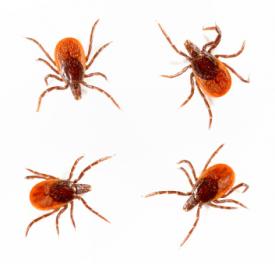HARDSCIENCEONLYME: Researchers Discover New Tick-Borne Illness Caused by Borrelia miyamotoi

Researchers have recently discovered that another species of Borrelia transmitted by deer ticks causes illness. The species, Borrelia miyamotoi, was discovered in Japan in 1995, but occurs in Asia, Europe and North America as well. A new study confirms that B. miyamotoi causes human disease "including relapsing disease that may last for months and may not respond to inappropriate antimicrobial drug therapy." Because B. miyamotoi is transmitted by an array of ixodid ticks and can be passed via the ovaries from one tick generation to the next, it "greatly expands the potential geographic distribution of this disease". The study notes that further investigation of possible B. miyamotoi infection in humans is warranted wherever I. pacificus, I. persulcatus, I. ricinus, and I. scapularis ticks are found.
Researchers from Russia worked with Drs. Durland Fish and Peter Krause of Yale to demonstrate that the B. miyamotoi caused human illness.
Platonov AE, Karan LS, Kolyasnikova NM, Makhneva NA, Toporkova MG, Maleev VV, et al. Humans infected with relapsing fever spirochete Borrelia miyamotoi, Russia. Emerg Infect Dis. 2011 Oct; [Epub ahead of print]
Transoverian transmittion of B. miyamotoi is discussed here.
The HARD SCIENCE ON LYME blog is written by Lorraine Johnson, JD, MBA, who is CALDA’s Chief Executive Officer. Contact her at lbjohnson@lymedisease.org.




















Not sure, but looks like there is a typo. "May not respond to inappropriate antimicrobial drug therapy" Is that supposed to be appropriate instead?
OK….confused here. So Borrelia burgdorferi is NOT passed on to tick larva by the adult female? That would mean that all tick bites by larva would carry no risk of Lyme Disease transmission, assuming larva feed once before molting to next stage??????
You mean, there is persistent Lyme, not persistent autoimmune reaction or merely crazy malingering? Those 'crusading women' were right!
I have heard that this strain sometimes causes more serious and resistant symptoms. Is there any information available about this?
Why not broaden the discussion to include all the species known to cause disease. This includes Eleven species from the B. burgdorferi s.l. complex were identified in and strictly associated with Eurasia (B. afzelii, B. bavariensis, B. garinii, B. japonica, B. lusitaniae, B. sinica, B. spielmanii, B. tanukii, B. turdi, B. valaisiana, and B. yangtze), while another 5 (B. americana, B. andersonii, B. californiensis, B. carolinensis, and B. kurtenbachii) were previously believed to be restricted to the USA only. B. burgdorferi sensu stricto (s.s.), B. bissettii, and B. carolinensis share the distinction of being present in both the Old and the New World. Out of the 18 genospecies, 3 commonly and 4 occasionally infect humans, causing Lyme borreliosis (LB) – a multisystem disease that is often referred to as the ‘great imitator’ due to diversity of its clinical manifestations
Its important to note that not only Borrelia miyamotoi causes infection undetected by the CDC 2T test but the test also fails with B. americana, B. andersonii, B. californiensis, B. carolinensis, and B. kurtenbachii, B. bissettii, B. carolinensis and loses sensitivity with some strains of B. burgdorferi according to Dr. Wormser.
There have only been minimal cases of non-B. burgdorferi infection detected since NO doctors outside very specific research labs have the tools able to detect them. There is no wonder few non-B. burgdorferi infections have been found. The CDC should immediately make a test capable of detecting these other species and has better performance with some highly immugenic strains that evade the CDC 2T antibody test. How many of the missed diagnosis are either distant strains of B. burgdorferi or
Borrelia miyamotoi
B. americana,
B. andersonii,
B. californiensis,
B. carolinensis,
B. kurtenbachii, or
B. bissettii,
or others yet to be found that have been found elsewhere. The trend is to slowly discover the geographic diversity is greater than believed and non-US species keep being found in US ticks, hosts or people.
Its not just Borrelia miyamotoi that is creating this problem plus its the lack of CDC 2T test sensitivity due to genotype diversity that is causing part of the problem….